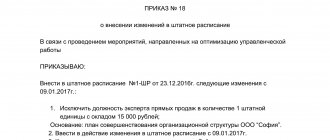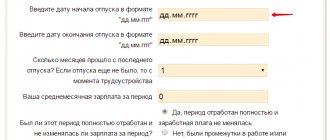On internal labor regulations (ILR)
The Labor Code of the Russian Federation determines that internal labor regulations are a local act of a company, formalized by an economic entity in accordance with the law.
It reflects the functioning of an economic entity, the work and rest schedules of its employees, as well as salary calculation issues.
Internal labor regulations implement legal norms in every enterprise; in no case should they make the working conditions of employees worse than the normative ones. It is advisable for all business entities that have employment contracts to develop this document.
Inspectors who conduct inspections of companies often request this local standard. Every organization must have labor regulations, otherwise administrative measures may be applied to it.
Attention! This document can be an independent act at the enterprise, or included in a collective agreement or other regulation as an appendix. Employees must have access to the Rules at any time of the working day.
Decor
When registering, it is recommended to pay attention to the presence of the necessary details:
- full and abbreviated name of the organization;
- name of the document type;
- details and name of the document by which they are approved;
- all pages are numbered.
If there are appendices to the rules:
- they are an inseparable part of the rules;
- must contain their full name and details of the document by which they are approved;
- have continuous numbering with PVTR.
According to the law, internal labor regulations are not required to be stitched and sealed. If they are stitched and sealed during registration, there will be no violation.
Are PVTR mandatory for LLCs and individual entrepreneurs?
Internal labor regulations are developed in accordance with the Labor Code of the Russian Federation in business entities without fail. This must be done by all organizations, including LLCs, as well as entrepreneurs acting as employers.
These acts may not be drawn up only by business entities classified according to certain criteria as micro-enterprises (for example, with up to 15 employees). They make up PVTR at will.
Such enterprises are allowed to waive their regulations in whole or in part. But they retain the responsibility to determine working conditions and conditions, so they must include this information in every contract drawn up during employment.
Responsibility for violation
Violation of internal regulations leads to the employee being held accountable. Moreover, the penalties depend on a number of factors, including repetition of the violation, etc. Labor legislation (Article 192 of the Labor Code of the Russian Federation) allows the use of the following types of punishment:
- comment;
- rebuke;
- severe reprimand;
- fine;
- dismissal.
Typically these types are used in the order listed, but this is not required. One manager can use only part of them, for example, only reprimand and dismissal. And another boss may be fined for a number of violations. The same applies to the number of violations (for example, for two lateness - a reprimand, and for three - a fine).
But no other penalties should be used. The exception is cases where the employee’s actions led to damage or death, as well as to a deliberate violation of the law.
The use of internal regulations for individual entrepreneurs is the same obligation as for legal entities. The content of the document remains unchanged. The differences relate only to the activities of individual entrepreneurs, as well as the ability to use a simplified form of PVTR, which is not recommended, since problems with subordinates may subsequently arise.
For more information about internal labor regulations, watch the video:
Do employees need to be introduced to them?
As a local regulatory act, it should be made available for review to all people working at the enterprise. The Labor Code of the Russian Federation establishes that the administration must familiarize all employees with its contents. By signing the sheet of familiarization with it, employees undertake to comply with the work schedule provided for therein.
Attention! In addition, the employee’s introductory signature allows him to prove his guilt if he does not comply with the rules established by this act. After all, only his visa shows that he knew these rules and deliberately violated them. In its absence, the employee cannot be brought to disciplinary liability if he violated the internal labor regulations.
What does the TC say?
In accordance with the Labor Code of the Russian Federation, PVTR is a local (internal) regulatory act in an organization. It regulates the main issues of relations between the administration and staff. The Labor Code does not say that PVTR are developed and approved by the employer (Articles 189 and 190 of the Labor Code of the Russian Federation).
The mandatory availability of this document is set out in the All-Russian Classifier of Management Documentation, approved by Decree of the State Standard of the Russian Federation No. 299 of December 30, 1993 (OK 011-93, class 02000000, code designation 0252131).
What should the internal regulations contain in 2021?
General provisions
It indicates exactly what issues are considered by this document, as well as how all employees are familiarized with it. If a company hires remote workers and homeworkers, it should also indicate how the company provides them with a copy of the rules and how they confirm that they have read them.
Hiring and firing process
This section includes a description of the procedure for hiring a new employee or dismissing an existing one.
In this section you can specify a list of documents that a new employee must provide to the HR department upon registration. However, in this case, you need to remember that a closed list of documents is established by the Labor Code, and the administration has no right to demand anything beyond it.
Also in this section you can record the tasks that the hired employee must complete before being hired.
It also reflects the process of passing the test, setting the salary, and the procedure for familiarizing yourself with internal documents. All of them must be introduced to each employee upon signature. There is no need to familiarize yourself with forms that will not be mentioned here.
This section may stipulate the procedure for full or temporary transfer to another position, the process of changing the terms of the employment contract.
Attention! When describing the dismissal procedure, it is necessary to describe the procedure and list of documents that must be given to him, as well as indicate the method of reporting on the property received for storage or use.
Rights and responsibilities of employees
In addition to the basic provisions, this section can include additional guarantees that employees can take advantage of - receiving additional education, providing hot meals, payment for travel, etc.
The responsibilities of the company administration can include all those points that it considers important - from discipline to compliance with the corporate style of clothing.
Rights and obligations of the employer
This should include those responsibilities that are included in current federal laws, as well as labor legislation. These provisions should relate to ensuring working conditions, safety at work and others.
This section can also include the procedure for providing guarantees that were specified in the rights of employees - payment for travel, payment for telephone calls on cellular communications, etc.
Work time and rest time
In this section you need to enter the duration of the working day in the company, the start and end time of work. If the employee is required to go to work on a day off, or on any special schedule, this should also be indicated here.
The section also includes the duration of the lunch break, its start and end times. If employees are required by law to provide additional rest time, this will also be noted here.
Next, the section contains a list of positions for which an irregular working day is established. Here you can also write down the conditions under which you can switch to part-time work, employees of which positions can do this, and how this is formalized.
Also here you can determine the principles on which the time sheet is drawn up, who is responsible for this, and stipulate any special cases. The latter may include a note on the employee’s lateness sheet, a reflection of part-time work, etc.
In this section, you need to describe the principle by which the priority of the right to choose vacation is determined, which of the employees has a priority right. Such categories are determined both at the legislative level and can be determined by the administration itself.
Attention! The rules can set a period of time during which an application for leave must be submitted if the employee requests it outside the developed leave schedule. However, it must be at least three days so that the accounting department has time to calculate and transfer vacation pay.
The process for granting additional leave, as well as which categories of employees are entitled to it, must be specified separately. For each of them, the duration of additional rest should be indicated here.
Rewards for achievements at work
In this section, you can describe what incentives an employee can receive for conscientious performance of duties, as well as the criteria necessary for receipt. Here you can write down a list of achievements for which you may be nominated for an award.
Responsibility of each party to the employment relationship
In this section, you can indicate possible violations that both the employee and the employer may commit in their work.
The degree of responsibility for these violations is also established here. It is possible that the list of violations of labor discipline that an employee may commit will be included in a separate section, indicating the penalties for each offense.
The procedure for issuing salaries
The Labor Code states that the exact dates on which the advance payment and the main part of the salary are issued must be specified in the internal regulations. If during the inspection it turns out that this is not indicated in the document, then fines will be imposed on the organization and responsible persons for the violation in accordance with the Code of Administrative Offenses.
According to the law, the rules must indicate exactly the dates, and not the intervals, when the organization can make payments. Also, according to the law, there cannot be more than 15 days between these two dates, and the remaining part of the salary cannot be paid later than the 15th day from the beginning of the month.
Attention! For new employees who are just joining the company, it is recommended to initially establish an individual payment schedule, according to which no more than 15 days would pass from the moment of acceptance to the first payment.
In addition to the dates and process for issuing salaries, in this section you can also specify the procedure for issuing pay slips, transferring sick leave and vacation pay, etc.
Final provisions
In this section, you need to indicate exactly how changes will be made to the document in the future, and through what process the rules are approved.
PVTR: from development to approval
Each organization must have its own internal labor regulations (ILR) <*>. They determine how work is organized for a particular employer. Let's consider what PVTR are, what is the procedure for their initial adoption and subsequent amendments to them.
General information about PVTR
PVTR are a local legal act (hereinafter referred to as LLA), which is permanently valid within a certain organization. Its norms are mandatory for both employees and the employer <*>.
Failure to comply with the PVTR may result in disciplinary liability for the employee, and administrative liability for the employer <*>.
Note! For the absence of PVTR in the organization, the guilty official of the employer may be brought to administrative liability in the form of a fine in the amount of 2 to 20 BV <*>.
Each organization develops PVTR independently. It is necessary to take the Standard PVTR as a basis. At the same time, a trade union must participate in the development of the PVTR, if there is one in the organization <*>.
The Standard PVTR contains general requirements for labor regulations. They need to be clarified and described in more detail in the organization’s PVTR, taking into account the specifics of its work and the established procedure of the employer.
PVTR created in the organization must not contradict current legislation. They cannot include conditions that worsen the employee’s position in comparison with labor legislation. Otherwise, the PVTR will be invalid. And not in terms of individual conditions, but completely as LPA <*>.
As a general rule, the issues regulated by the PVTR include <*>:
1) the procedure for hiring and dismissing an employee;
2) the main responsibilities of the parties to the employment contract.
Note : An employment contract with an employee does not necessarily include the entire list of his or her job responsibilities. It is enough to list them in the employee’s job description (work description), which in this case is attached to the employment contract <*>.
Note! The employer is obliged to inform the employee, against signature, of the changes in his job duties. We believe that this rule also applies when the employee’s duties set out in the PVTR <*> change;
3) working hours and rest hours. In particular, in the PVTR it is necessary to establish the beginning and end of the working day, the time and duration of the lunch break, weekends and working days, etc.
Please note: Work and rest schedules may differ for different categories of workers. As a rule, the PVTR establishes a common work and rest schedule for most workers. If the regime for a certain employee is different, information about this must be indicated in the employment agreement (contract) with the employee. If the regime is the same as in the PVTR, it is enough to make a reference to the PVTR <*> in the employment contract;
4) types of incentives for employees for success at work, as well as the procedure for their application. As an incentive for an employee of a commercial organization, you can establish, for example, an announcement of gratitude, a bonus, a valuable gift, a paid day off, placement on the Honor Board, etc.;
5) types and procedure for applying disciplinary measures to employees. The PVTR cannot establish its own procedure for bringing employees to disciplinary liability, since such a procedure is strictly regulated in the Labor Code.
It is not prohibited to include provisions and sections not provided for in the Model PVTR. For example, provisions on the employee’s financial liability, etc. can be included in the PVTR.
Note! PVTR must be kept in the organization for one year after replacement with new ones <*>.
Procedure for approving PVTR (amending)
The procedure for approving PVTR by an organization is not directly prescribed by law. In this case, you need to adhere to the general rules for accepting LPA by the organization.
We believe that the algorithm for making changes to the PVTR is generally the same as the algorithm for introducing new PVTR. In this regard, the article provides a general algorithm of actions for both cases, indicating the features of each, if any.
The sequence of actions for approving the PVTR can be presented as follows <*>.
Step 1. Development of the PVTR project
It begins with identifying responsible persons and development timelines.
It is advisable to include specialists with knowledge of the Labor Code, other labor legislation, office work and document management among those responsible for the development of the PVTR. For example, a human resources specialist, a legal adviser, a secretary, etc. After all, PVTRs affect labor issues, and their preparation is subject to office work requirements.
The employer can assign responsibility for the development of PVTP to one specialist or to an entire working group consisting of several specialists. As a rule, this depends on the amount of work required to compile (change) the PVTR, as well as whether the organization is large or small.
As a rule, the decision of the head of an organization to develop PVTR is formalized by an administrative document (in particular, an order from the director). It is advisable to determine the timing and activities for the development of PVTR, as well as to appoint persons responsible for this <*>.
An example of the wording of an order on the development of internal labor regulations In order to create conditions conducive to strengthening labor discipline, efficient work, rational use of working time, on the basis of Art. 195 of the Labor Code of the Republic of Belarus, clause 4 of the Model Internal Labor Regulations, approved by Decree of the Ministry of Labor and Social Protection of the Republic of Belarus dated 04/05/2000 N 46 (hereinafter referred to as the Model Rules), I ORDER: 1. To form a working group to prepare the Internal Labor Regulations (hereinafter referred to as PVTR) ASKero LLC, composed in accordance with Appendix 1 to the order. 2. The working group will develop a PVTR based on the Model Rules, taking into account labor legislation and the employer’s labor regulations. 3. Present the draft PVTR to the working group: 3.1. for approval by the head of the legal department and the chief accountant - until January 15, 2020; 3.2. for agreement with the trade union - until 01/22/2021; 3.3. for approval by the director of ASKero LLC - until 02/01/2021. 4. Familiarize workers with the approved PVTR by 02/15/2021. 5. Entrust control over the execution of this order to the head of the HR department, L.I. Sidorova.
It may happen that changes to the PVTR will entail a change in significant working conditions. For example, when establishing a new working time regime or labor standards for employees in the PVTR. As a general rule, changes in essential working conditions must be justified by production, organizational or economic reasons. In this case, employees must be notified of the revision of significant working conditions no later than one month before the introduction of new ones <*>.
Note! At the moment, the essential working conditions of employees can also be changed if they are related to the unfavorable impact of the epidemiological situation on the activities of the employer. The notice period for the employee in this case is one calendar day. This rule does not apply to cases where an employee’s wages are reduced <*>.
When changing the PVTR insofar as it affects essential working conditions, it is important to justify these changes in the order. If at the time of drawing up the order it is known how the essential working conditions for employees will change, it is advisable to familiarize them with such an order. This will make it possible to comply with the legal requirement for advance warning of workers about changes in significant working conditions <*>.
Step 2. Approval of the PVTR project
After preparation, the draft PVTR may be subject to approval <*>:
1) within the organization - with structural divisions and officials.
Internal coordination (vising) of the PVTR with certain officials of the organization is necessary if this is provided for by the relevant LPA. For example, regulations on structural units or job descriptions for employees. As a rule, such a right is granted to the head of the legal department, personnel department, etc. <*>.
Validation is carried out by putting the “visa” detail on the front side of the last sheet of the draft PVTR on the left side. This detail includes the date of endorsement, the position of the endorser, his handwritten signature and its transcript. If a document is endorsed by several persons, the visas are located one below the other in the order of endorsement <*>.
During the approval process, you cannot make any corrections to the text of the document. The endorser has the right to make his comments and additions below the endorsement date. If there are many comments, they should be reflected on a separate sheet, and the note “Comments are attached” should be made on the draft document <*>;
2) outside the organization - with a trade union (if there is one in the organization).
PVTR must be agreed upon with the trade union, if there is one in the organization. Coordination of the PVTR project with the trade union is formalized with an approval stamp on the front side of the last sheet of the document. Since the trade union is a collegial body, its decision to approve the PVTR is made at a meeting and documented in minutes. The union approval stamp will look like this <*>:
AGREED Minutes of the meeting of the trade union committee (date) N (number)
Step 3. Approval of PVTR
Approval of PVTR is a mandatory stage for putting them into effect, since PVTR come into force from the moment they are approved by the head of the organization <*>.
Approval of the PVTR can occur in two ways of equal legal force <*>:
1) by issuing an administrative document (order, instruction) by the manager. This method of approval is usually used when the introduction of a document requires additional instructions, clarification, or actions related to its use. For example, the introduction of PVTR should be accompanied by familiarization of the organization's employees with them <*>.
When choosing this method of approving the PVTR, it is advisable to provide the following information in the order: the date of introduction of the PVTR, the need for employees to familiarize themselves with the order, indicating the deadlines for familiarization. In this case, the approved PVTR are attached to the order.
An example of the wording of an order ... On approval of the Internal Labor Regulations In connection with the change in the Internal Labor Regulations (hereinafter referred to as the PVTR), I ORDER: 1. To approve the new edition of the PVTR 02/01/2020 in accordance with the draft PVTR dated 01/15/2021 attached to the order. 2. This order should be brought to the attention of all employees no later than 02/15/2021. 3. Entrust control over the execution of the order to the head of the personnel department, I.I. Grigoriev.
The contents of the approval stamp in this case will be as follows: the word “APPROVED”, the name of the type of document in the nominative case, its date and registration index <*>;
An example of an approval stamp APPROVED Order of the Director of ASKero LLC 02/01/2021 N 12
2) by putting a handwritten signature on the approval stamp by the head of the organization.
The approval details in this case include <*>:
- the word “APPROVED”;
— name of the position of the person approving the document;
— type and name of the organization;
— official signature with transcript;
— date of approval.
Example of an approval stamp I APPROVED Director of ASKero LLC Signature I.I.Dubaev 02/01/2020
Note! After approval of the PVTR, this LPA should be assigned a registration index <*>.
Step 4. Familiarization of workers with PVTR
The employer is obliged to familiarize the employee with the PVTR upon signature upon hiring. This allows the employer to demand that the employee comply with the PVTR <*>.
Employees may be familiarized with the PVTR upon hiring by signing:
- on the familiarization sheet attached to the PVTR or directly to the employment contract itself;
— in the magazine for familiarizing employees with the LPA;
- on the last sheet of the PVTR.
The procedure for familiarizing employees in the event of subsequent changes to the PVTR may be as follows:
1) when the PVTR is approved by order of the manager, employees must be familiarized with this order and signed;
2) when approving the PVTR by putting a handwritten signature on the approval stamp by the head of the organization, employees can be familiarized with the PVTR by affixing their signature:
— on the LPA itself;
— the familiarization sheet attached to the PVTR.
Note: Current PVTR must be placed in a place that is accessible to employees for viewing <*>.
Read this material in ilex >>* *follow the link you will be taken to the paid content of the ilex service
How to approve PVTR
When developing rules, a wide range of company specialists are usually involved in the process. These must include economists, lawyers and personnel personnel. At the same time, in their work they must take into account all the specifics of the enterprise, industry, product or service.
Once drafted, the draft document must be submitted to trade union representatives for review. This step is enshrined in law. They are given five days to review the document. The opinion expressed by the body can be either positive or negative.
In the latter case, an approval process must be carried out, which can take a long time. However, the administration, if the parties do not reach agreement for a long time, can approve the internal labor regulations of the organization in this form.
If this local normative act is included in the collective labor agreement, then the rules must then be registered with the labor inspectorate within seven days.
The final stage is the issuance of an order approving the labor regulations of the enterprise, which will put the document into effect. A person vested with the necessary powers, usually the director, has the right to sign it.
Attention! The adopted rules are subsequently used when drawing up employment contracts with employees.
Basic rules of PVTR
The main parameters of the labor schedule and labor discipline are set out in Article 189 of the Labor Code of the Russian Federation. These are the ones that must be followed when developing VTR rules. In this case, it is necessary to apply it to the specifics of the enterprise and corporate characteristics. The law does not establish a strict form of the document, so the employer has the right to decide for himself in what composition and scope it will be developed and approved.
The basic principles for drawing up the document are the following:
- The content of the rules should cover all aspects regarding the work and rest of employees, remuneration, rights and obligations of both parties to the employment contract.
- The general section may contain terms and their definitions that are used in the text of the rules.
- Additionally, in the section related to the procedure for hiring, transferring and dismissing employees, a list of documents required for this may be specified. It should be taken into account that these requirements must comply with labor legislation and not contradict other legislative acts.
- Mandatory compliance of the rights and obligations of employees and employers with current legislation. You should refer to Articles 21 and 22 of the Labor Code and the norms approved by law.
- It is unacceptable to infringe on the rights of workers in the organization and impose responsibilities that may be regarded as unnecessary. To assess this, it is necessary to coordinate the internal labor regulations with the trade union cell.
- The procedure for remuneration, as well as types of incentives, are established.
- The employer has the right to indicate the grounds for applying penalties, describe the procedure for their imposition, as well as the type in each specific case.
- Features of the organization's activities may be the traveling nature of the work associated with business trips. The procedure for sending and paying relevant expenses is prescribed in a separate paragraph.
- Additionally, information about payment for cellular communications, fuel, medical insurance and others provided to employees of the organization or a group of employees may be specified.
- Other parameters present in the institution, such as: dress code, access control, trade secrets, etc.
How to make changes to PVTR
Over time, changes and amendments may be made to the main legislative acts, and new organizational and technological processes may be introduced into the work of the enterprise. In order for previously adopted internal labor regulations to always be relevant, they need to be amended in a timely manner.
The need to make changes is documented in an official or memo addressed to the company administration. After this, the administrative act must appoint persons who will be responsible for developing a new version of the rules.
Since the procedure for amending the laws is not specified anywhere, it is recommended that when developing and adopting a new version of the rules of procedure, one should adhere to the procedure carried out during the primary process.
Important! After accepting the new version of the document, all company employees must be familiarized with it against signature.










